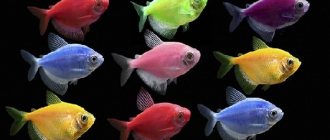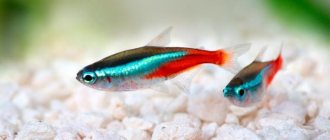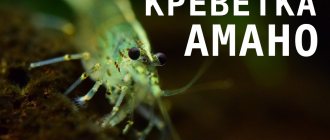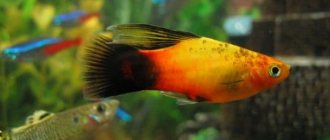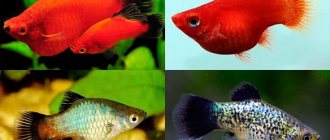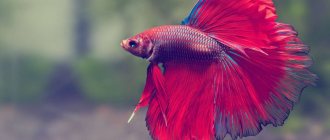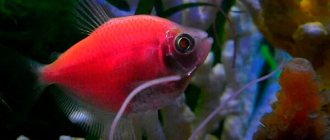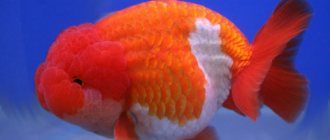Acantophthalmus (Pangio) is a genus of small Asian freshwater fish from the loach family Cobitidae. The graceful shape of this genus of fish sets them apart from all other members of the loach fraternity.
They also have a relatively large number of vertebrae, with their dorsal fin located behind the ventral fin.
Snake-like bottom-dwellers, they are widespread across Southeast Asia, and different species are found in a wide variety of environments, from still water to calm flowing water.
The bulk of Pangio can be found in shallow, slow forest streams or creeks, often among peat bogs, in which tannins color the water, giving it sour and soft properties.
Such streams are often shaded by the rainforest canopy and abundant marginal vegetation along the banks. The substrate is usually sand, silt, mud and peat.
Leaves from trees fall into the water, forming large accumulations, and when decomposed, they form the favorite habitats of these fish.
Like other loaches of the Loach family (Cobitidae), they have sharp suborbital spines that are almost invisible, as they lie flat and are well hidden in a leather pouch. However, when threatened or stressed, the spines quickly rise.
Table of basic parameters of maintenance, care and nutrition:
| What should be the volume of the aquarium? | from 10 liters per 1 individual |
| What should the temperature be? | from +21-28°C |
| What pH should be in the aquarium? | from 6-7.2 pH |
| What should the water hardness be? | up to 5-15°dH |
| What should the substrate be? | no sharp corners |
| What kind of lighting should there be? | moderate |
| What should be the movement of water | moderate |
| Maximum fish size | from 3-12 cm (depending on the type) |
| What does it eat? | dry, live and frozen food |
| Type of aquarium fish | not aggressive |
| Who is compatible with in an aquarium? | get along with small non-aggressive fish species |
Maintenance and care
The recommended capacity of the aquarium is from 10 liters per 1 individual.
Water requirements:
- sour and soft;
- temperature: from +21-28° C;
- from 6-7.2 pH;
- hardness: from 5-15° dH; Peat filtration may be useful for these purposes.
The bottom must be lined with a soft sandy substrate and decorated with driftwood, even and smooth stones, as well as round pebbles. When using fine gravel, its surface should be smooth. Loaches love to dig into the substrate with their noses, and some of their species burrow into it, sticking out only their mouth.
A thin, smooth substrate will not only protect the delicate sensory antennae, but also prevent damage to their small bodies.
Good filtration of water in the aquarium is necessary. There is a risk that loaches may become trapped in filters or attachments due to their small size. To avoid such a situation, the flow rate should not be high.
Description
Adults reach a length of up to 28 cm. The fish has an elongated, serpentine-shaped body. The color is sandy with rows of dark specks. On the head near the mouth there are four pairs of sensitive antennae. The fins and tail are short and translucent.
Brief information:
- Aquarium volume - from 200 liters.
- Temperature - 5–25°C (optimal 17–23°C)
- pH value – 6.0–8.0
- Water hardness - soft to medium hard (1–12 dGH)
- Substrate type - soft sand
- Lighting - dim
- Brackish water - no
- Water movement – little or no movement
- The size of the fish is up to 20 cm.
- Food - any sinking food
- Temperament - peaceful
- Living alone or in a group
What to feed
Acantophthalmus are micropredators that sift pieces of substrate through their mouth and gills. Insect larvae, small crustaceans, etc. are extracted from it, with part of the natural diet consisting of organic detritus and plant material from the prey's intestinal contents.
In the aquarium, they should be fed dry food made from sinking pellets, but it is advisable to offer regular food from live and frozen food: daphnia, brine shrimp, bloodworms, microworms, grindal, etc.
Feeding
Loach fish are voracious, and in their natural habitat they happily eat larvae, crustaceans, worms and vegetation. Squeakers especially love alien caviar, which the fish skillfully find in lakes thanks to their tactile antennae. At home, loaches are fed the following foods:
- bloodworm;
- meat;
- worms;
- tubifex;
- frozen and dry food.
If pets are kept with other fish, it is important that there is enough food, otherwise the loaches will take food away from weak and non-conflicting neighbors. Squeakers pick up food from the bottom, so floating species are not suitable for fish.
Interesting fact: loachfish can fast for up to 5 months without harm to their health.
Reproduction in an aquarium
Unfortunately, only a few species have been successfully bred in home aquariums, and this happened by accident!
Pangio oblonga appears to be the most frequently spawning species. Although male courtship with a female was not detected, the fry were found among the filter panels and between the rounded surfaces of gravel.
Another species that has been bred in captivity is Pangio doriae.
Breeding loaches can be a very difficult task, but it can be done if you create a breeding aquarium with certain conditions:
- maintaining low water levels in very dim light;
- the presence of floating plants in which females lay eggs, and dense vegetation also promotes spawning;
- reducing water hardness to pH 6.5.
The more comfortable the loaches are in the aquarium, the greater the likelihood that they will spawn. When keeping members of their own species in a community, the chances of spawning increase due to collective spawning.
To stimulate spawning, fish should be fed live food.
Breeding this type of loach requires patience, as they only reach sexual maturity at 2 years of age.
The females grow very large when they lay their eggs. Sometimes you can see the eggs through their skin. When the females are ready to spawn, they will release bright green colored eggs that will attach to the underside of floating plants in the aquarium.
After spawning, it is necessary to isolate the adults, otherwise they will eat the fry and eggs.
The fry from the eggs hatch in about 24 hours. You can feed them ciliates or brine shrimp.
Content complexity
A simple and hardy aquarium fish. What distinguishes it from other fish is the absence of scales; this makes acanthophthalmus very sensitive to medicinal drugs. Therefore, in aquariums in which these fish are kept, treatment with potent drugs, for example containing methylene blue, must be carried out very carefully.
They love clean and well-aerated water, as well as regular changes. During water changes, it is necessary to siphon the soil, removing waste, since loaches, like fish that live on the bottom, get the most from decay products - ammonia and nitrates.
Sometimes aquarists wonder if he is a predator? But, just look at the mouth, and doubts disappear. Small, it is adapted for digging in the ground and searching for bloodworms and other aquatic insects.
Peaceful, Kühl's acanthophthalmus is predominantly nocturnal and is most active at night.
It is quite difficult to notice him during the day, especially when he is alone in the aquarium, but it is quite possible if you watch for some time. If you keep several fish, then activity increases during the day, this is due to food competition. A group of half a dozen will behave more actively, as they behave in nature, but it is quite possible to keep one individual.
They are quite hardy fish and in captivity can live for quite a long time, without particularly suffering due to the lack of company.
How to distinguish female and male
The sex of adults is usually determined without difficulty. During pregnancy, the female has a large belly, where greenish eggs can be seen. Thickening of the second thoracic ray, and sometimes the third ray, is characteristic of males of the species P. alcoides, P. incognito and P. pulla.
In addition, males can be distinguished from females using the pectoral and ventral fins, which are shorter in females than in males. This applies to most Pangio species.
Who can you keep in an aquarium?
Acantophthalmus are peaceful in nature. They are best kept with other small non-aggressive fish - Neon , Mollies, Corydoras, Danios, Rasboras, Guppies, Tetras, Swordtails, Norman's Blueeyes, Small Catfish.
Loaches spend most of their time swimming along the bottom, collecting garbage and eating leftover food that ends up on the sand. Therefore, their ideal aquarium companions are those fish that occupy the upper areas of the aquarium.
Aquarium shrimp Cardinal and Cherry shrimp are also good aquarium mates.
Gourami can make a worthy company, since most of the time they swim either in the middle or in the upper part of the aquarium.
Fish that should not be placed in an aquarium with Acantophthalmus:
- cichlids, arowana and other large fish;
- tiger Barbus, Girinocheilus and other fish that have aggressive behavior and can cause injury to Acantophthalmus;
- Blue Gourami, Cockerel and Red-tailed Sharks drive other fish out of their territory. In a limited capacity, particularly in an aquarium, this increases the risk of Acantophthalmus jumping out of the aquarium.
It is not advisable to place loaches together with predatory aquarium snails.
Features of behavior
Spiny eyes have their own interesting behavioral characteristics. They have intestinal respiration. And if the fish suddenly rises to the surface, then there is no need to worry, it simply takes in air into the intestines. Oxygen can also enter the fish’s body through the skin.
If the loaches are dancing wildly in the aquarium, there is nothing to worry about, this is how they react to a sharp change in atmospheric pressure.
Intestinal respiration is one of the characteristics of fish
Acantophthalmus Culey or Külya (Kuli)
Found in Southeast Asia, Malaysia, Sumatra and Borneo. However, the full extent of its spread still remains unclear.
This is a small fish similar to an eel. It can reach a maximum of 12cm in the wild and will be slightly smaller in a home aquarium (usually around 8cm). She has 4 pairs of antennae around her mouth and small fins.
Unlike many other fish, their dorsal fin starts well behind the middle of the body, and their eyes are covered with transparent skin. They usually have 10 to 15 dark vertical stripes with a pinkish-yellow color in the middle. The lower part is usually lighter.
A characteristic feature is that they have very small scales on the body and their complete absence on the head; this feature makes them extremely susceptible to disease.
Males and females look very similar. The only differences are that males have a more muscular cross-section of the back and larger pectoral fins. Females become larger as they breed and their eggs can be seen through their skin before spawning.
Common types of loaches
Let's get acquainted with the common types of fish described. For the convenience of users, the information is presented in table form.
Table. Overview of common loach fish species.
| Name, photo | Short description |
| Common loach (lat. Misgurnus fossilis) | A species widely distributed in fresh water bodies of Europe and Asia. Moreover, the fish prefer muddy reservoirs. Misgurnus fossilis is unpretentious to living conditions, and therefore can easily live where there are no other species. |
| Common (Siberian) spined loach (lat. Cobitis taenia) | The smallest representative of the loach family. Lives in reservoirs of almost all of Europe, with the exception of northern countries, as well as in some Asian countries. The body length can reach 10 cm. The color is light yellow, with large spots on the sides, merging into a stripe. |
| Amur loach (lat. Misgurnus anguillicaudatus) | Lives in Japan, China, Sakhalin. Can grow up to 25 cm in length. The body of the Amur loach can be yellowish-copper or light brown in color. |
Acantophthalmus Myers
Distribution : Thailand, Laos, Cambodia.
On its orange body it has 8-11 very wide, quadrangular, regular stripes of dark color; black or with a large black spot at the base of the caudal fin.
Common name : giant coolies, Myers loach, Myers coolies.
Sexual dimorphism : females, as well as other Pangio species, become noticeably plump during pregnancy. Caviar can be seen in the abdominal cavity.
Maximum size: 10 cm.
Similarities to Other Species: The immature fish may be confused with other striped coulees. Adults do not raise any doubts.
Maintenance and Care : All Coolies require established aquariums and should not be placed in new ones. It is necessary to create many secluded places for them with a soft substrate. It is best kept in groups, and the larger the group, the better. Three individuals is the absolute acceptable minimum for their coexistence.
Feeding : good quality flakes, sinking granules, bloodworms thawed after freezing, brine shrimp, etc.
Water requirements : from 6.5-7.2 pH; hardness: from 5-12° dH.
Temperature: from +25-28° C.
Reproduction: females noticeably gain weight from the eggs. The male courts the female, wrapping his body around her. Green eggs are deposited in floating vegetation. The fry hatch in about 24 hours.
Appearance
Representative of the Vyunov family. The usual length is 16-25 cm, occasionally longer, and the weight of some individuals is up to 50 g or more. The body color of the loach largely depends on the living conditions. Usually its back is brown with dark specks, its sides and belly are yellowish, but in clear water lighter, bright yellowish tones predominate. On the sides of the fish’s body there are 3 dark stripes, of which the wide middle one goes from the eye to the caudal fin.
Video. Loach in the aquarium:
The body is at first almost cylindrical, then somewhat laterally compressed. The head is small, with 5 pairs of antennae (2 on the upper jaw, 1 pair at the corners of the mouth, 2 on the lower jaw). The eyes are small, yellow or brown. The fins are rounded, with dark spots. The scales are small, the lateral line is invisible.
Video. Loach in search of shelter:
It is almost impossible to hold a loach in your hands. It is like a small slippery snake, literally seeping through your fingers. There is an opinion that a loach can be held in a child’s hand without much effort.
Video. Shifty loach:
Acantophthalmus semi-girdled
This species is one of the most commonly misidentified by aquarists, who almost always call it P. Kuhlii.
It is now generally accepted that it occurs in the shallow waters of Peninsular Malaysia, the Greater Sunda Islands, Sumatra and Borneo, but the true extent of its distribution is unclear.
Many such environments are associated with ancient peat bogs and contain black water, although it also occurs in clear waters which may be stained to some extent by tannin. Such habitats are usually shaded from the sun by marginal vegetation and dense tree canopies.
The water typically has little dissolved mineral content, is poorly buffered, and the pH can reach 3.0 or 4.0 due to the gradual release of tannins and organic acids from decaying plant material.
The main body color is salmon-pink, which varies among specimens from pink to beige or orange with a distinct pinkish tint near the gills. Dark brown markings that form stripes; these stripes are found on the upper part of the body and are irregularly shaped. Two maxillary barbels are located at the tip of the snout.
Maximum size : 10 cm.
Maintenance and care : for this species, we recommend an aquarium with a base size of at least 60 * 30 cm and a volume of at least 76 liters, for which a filter with a water flow of 4-5 times the volume of the aquarium is best suited. For each individual added to the aquarium, an additional 12-19 liters of water are required.
It is best to use a soft sandy substrate as this species loves to burrow and tends to spend some time completely underground.
If coarser gravel is used, it may become stressed or injure itself, resulting in feeding problems.
A few pieces of driftwood, placed to create plenty of shady areas, can be used to create beautiful topography, and the addition of dried leaf litter will provide additional cover and help mimic natural conditions.
For aquatic plants of genera such as Microsorum, Taxiphyllum and Cryptocoryne, it is best to use fairly dim lighting.
Gentle filtration of the water is optimal, providing little surface agitation, so it is best to avoid high flow rates. This is also advisable because it reduces the risk of small animals getting into the filter inlets.
The aquarium should be covered from above, since most loaches jump from time to time, especially when they find themselves in a new environment.
These fish perform best when kept in a group of 6 individuals. If they are kept alone, they will become very shy and will hide most of the time.
Feeding : dry food in the form of sinking granules, live and frozen daphnia, brine shrimp, bloodworms, microworms, grindal.
Water requirements:
- temperature: from +21-26° C;
- from 5.5-6.5 pH;
- hardness: from 6-8° dH.
These fish are extremely difficult to breed, so don't be discouraged if they don't breed.
Acantophthalmus diseases
This species is more susceptible to disease than many other aquarium fish. It is believed that this predisposition may be due to the lack of scales on their body and head.
They are incredibly sensitive to chemicals, antibiotics and other elements in the water. This is why filtration systems are so important to their survival and health.
An individual suspected of having the disease should be immediately placed in a separate tank, which is best kept always ready, since Acantophthalmus often gets sick.
Sudden changes in temperature, colder water, etc. increase their likelihood of contracting something unpleasant.
The most common disease in this species is “white spot disease,” which is caused by the parasitic ciliate lchthyophthirius multifiliis. Small white dots up to 1 mm in size appear on the fish.
The parasite attacks the fins and from there spreads gradually throughout the fish’s body. Parasites often attack the gills, making breathing difficult.
Due to the increased sensitivity of Acantophthalmus, the dosage of medications for their treatment is reduced either by half or given less than the standard dose.
Fish are also very susceptible to something called Skinny Disease. This disease can be diagnosed quite easily - Acantophthalmus loses weight, despite proper nutrition.
This disease is caused by internal parasites and must be treated with antibiotics.
Conclusion
These beautiful fish require special attention as they are very susceptible to disease if not kept in a proper environment with good oxygenation and frequent water changes.
Breeding Acantophthalmus is very difficult, but it can be useful for gaining invaluable experience if successful.
Compatibility
Acantophthalmus Kühl is an extremely peaceful fish that spends its time searching for food at the bottom of the aquarium. Hidden during the day, it becomes active in the evening and at night. Not being a pack, it behaves more openly in a group. It is very difficult to see alone.
The fish is compatible with all non-large and non-aggressive species of aquarium fish. He gets along well with shrimp, as he is too slow for these nimble creatures and has a small mouth.
Of course, he will swallow a small shrimp that is gaping, just like any fish. But in practice this is extremely unlikely. They are good for shrimpers and herbalists.
But for keeping with American cichlids - it’s bad, especially with large ones. They may perceive it as food. In general, acanthophthalmus itself does not pose any threat to other fish, but it can become a victim for predatory, aggressive neighbors.


